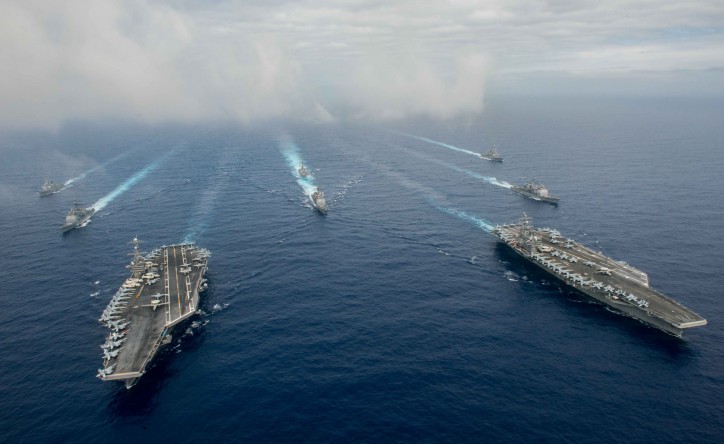Two U.S. aircraft carrier strike groups kicked off operations in the Philippine Sea over the weekend in a clear sign of Washington’s enduring presence in the region ahead of a much-anticipated verdict on Manila’s South China Sea case against China, defense officials confirmed.
U.S. officials had been examining the potential of two aircraft carriers operating together in the Pacific, which U.S. senator John McCain had called a “strong statement” of American commitment to regional security in a speech in Singapore earlier this month ahead of the Shangri-La Dialogue.
On June 18, ships and aircraft assigned to the USS John C. Stennis (CVN 74) and USS Ronald Reagan (CVN 76) strike groups began dual carrier flight operations in the Philippine Sea.

The Nimitz-class aircraft carriers USS John C. Stennis (CVN 74), left, and USS Ronald Reagan (CVN 76) conduct dual aircraft carrier strike group operations in the U.S. 7th Fleet area of operations in support of security and stability in the Indo-Asia-Pacific. - Image: US Navy
“The ships and aircraft assigned to both strike groups began coordinated operations in international waters demonstrating the United States unique capability to operate multiple carrier strike groups in close proximity,” a U.S. Navy statement said.
The two strike groups reportedly conducted a range of activities including air defense drills, sea surveillance, defensive air combat training, long range strikes, and coordinated maneuvers.
“This is a great opportunity for us to train in a high end scenario,” said Rear Adm. John D. Alexander commander, Battle Force 7th Fleet and commander of Carrier Strike Group (CSG) 5. “We must take advantage of these opportunities to practice warfighting techniques that are required to prevail in modern naval operations.”
U.S. aircraft carrier strike groups have conducted joint operations before in the Western Pacific in recent years, including in the South China Sea, East China Sea and Philippine Sea. Typically, these operations would occur when strike groups deployed to the 7th Fleet area of operations from the West Coast of the United States are joined with the forward deployed carrier strike group from Japan.
But the timing of this coordinated operation – coming just ahead of an upcoming verdict by the Hague-based Permanent Court of Arbitration (PCA) on the Philippines’ South China Sea case against China – makes its message clear. Washington and regional actors have been weighing their options following the much-anticipated decision, which is expected to be ignored by China amid Beijing’s continued assertiveness in the South China Sea.
The United States and the Philippines, for their part, have continued regular interactions on the defense side designed to reaffirm the strength of their alliance even amid recent uncertainty with the election of Rodrigo Duterte as the next president of the Southeast Asian state. In May, the USS John C. Stennis Strike Group was on a port visit to the Philippines’ Subic Bay. And earlier this month, the U.S. Navy dispatched four U.S. Navy EA-18G Growler airborne electronic attack aircraft and about 120 military personnel to Clark Air Base, just months after the two sides had agreed on a series of initial locations as they begin implementing the Enhanced Defense Cooperation Agreement (EDCA). Planning for next year’s iteration of the Balikatan Exercises has also begun.
Source: The Diplomat